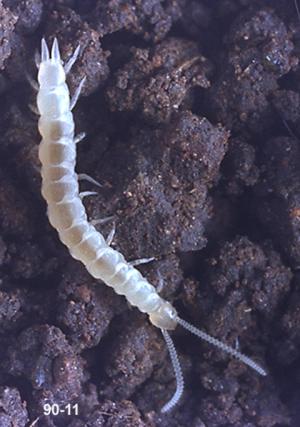Contents
Identification
Life Cycle
Management
Fact Sheet
(requires Acrobat Reader 3.x or
above to read and print. Click below to download the free "Reader".)

Registered
Insecticides
References
[Insect
Management]
[Home] |
|
 |
Symphylans are not insects. They are 3
to 6 mm long, white, with prominent antennae and numerous legs. Newly hatched nymphs
have six pairs of legs, but at each molt an additional pair of legs is added, until the
adult stage, which has 12 pairs of legs. Eggs, nymphs, and adults can be found in any
month of the year, but the majority of eggs are found during the spring and fall. Eggs are
laid in clusters of 4 to 25 at various depths in the soil depending on soil temperature,
moisture, and structure. Eggs hatch in about 40 days and nymphs begin feeding on small
roots. Nymphs and adults become active in the spring and can be found in increasing
numbers in the upper 12 to 15 cm of soil during the spring and early summer. The total
development time from egg to adult takes about five months at 10 C. There are one to two
generations each year. Symphylans are often found damaging plants in spots in the field.
Identification of these areas greatly simplifies control. |
Garden Symphylan Adult |
View the Fact
Sheet for More Information |

|
Garden Symphylan
Adult |
This section contains information on identification of
symphylans in peppermint. The Fact
Sheet contains specific information on identifcation and biology of this
pest (requires Acrobat Reader). Symphylan damage is most common in fields West of
the Cascade Mountains. |


